|
|
On Training Form 15, the grantee provides details on the providers participating in consultation (teleconsultation and in-person) and care coordination support services, as well as training provided by the Pediatric Mental Health Care Access (PMHCA) program and the Screening and Treatment for Maternal Mental Health and Substance Use Disorders (MMHSUD) program during the reporting period. The grantee also provides details on individuals served by PMHCA and MMHSUD during the reporting period. The form will display as “Training 15” under the ‘Training and Workforce Forms’ section on the left menu. |
|
| Form | Report Types |
|---|
NCPR | NCCPR | PPER | | Training Form 15 | X | X | X |
The report types are as follows: - New Competing Performance Reports (NCPR)
- Non-Competing Continuation Performance Reports (NCCPR)
- Project Period End Reports (PPER)
|
|
Data will not pre-populate from one report to the next report. The grantee is required to enter the data in each report for this form, if applicable. |
|
|
In this section, the grantee may expand the accordion menu to view the following details: - Training 15 – Consultation and Training for Mental and Behavioral Health
- Performance Measure
- Goal
- Level
- Domain
- Definition
- Benchmark Data Sources
- Grantee Data Sources
- Significance
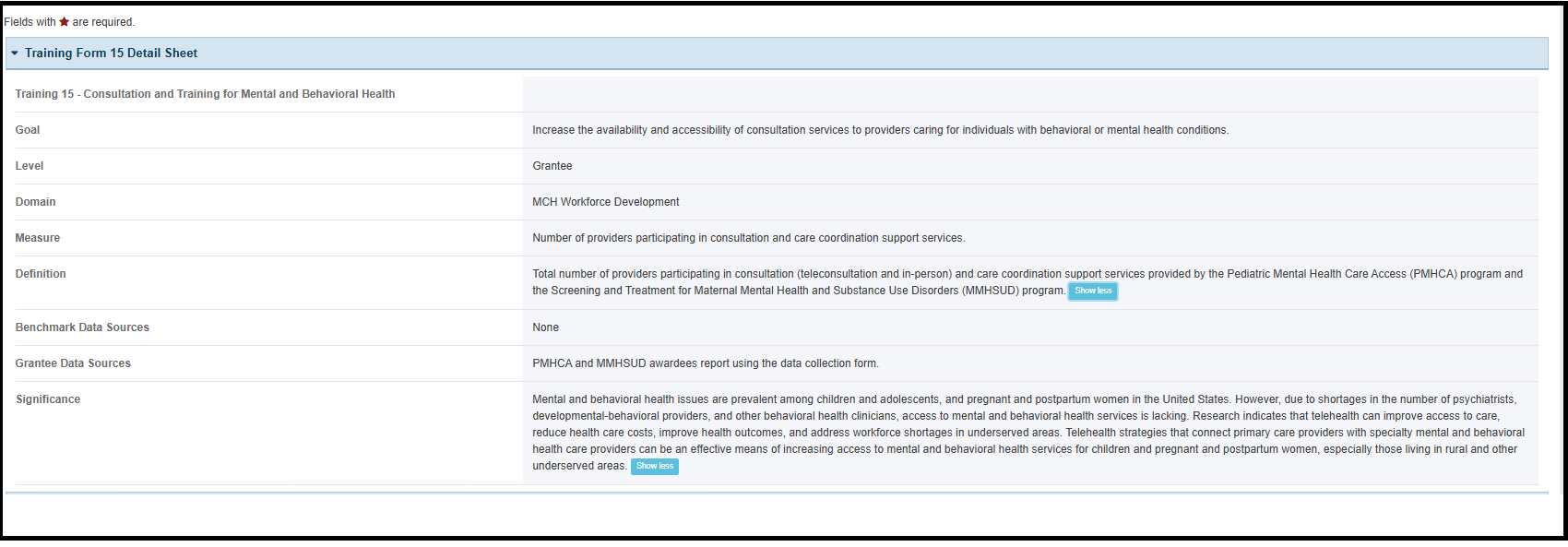
|
|
In this section, the grantee may expand the accordion menu to view the following details: - Definitions
- Tab A Instructions
- Tab B Instructions

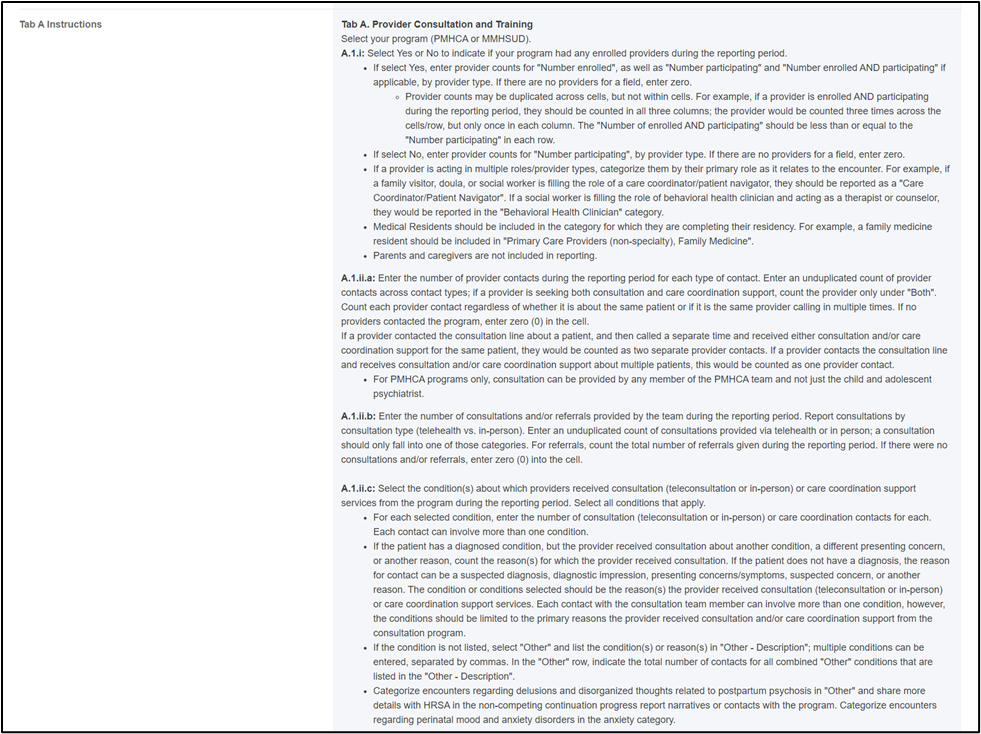


|
|
The grantee must provide data for all the sections on the following two tabs: - Provider Consultation and Training
- Individuals Served

|
|
The grantee may click on this tab and see the following sections: - 1. Consultation
- 2. Training
The grantee must answer the following question under this tab: Please select the program you are reporting about - This is a required question, and the grantee must select the PMHCA or MMHSUD option using the radio buttons.
- If the grantee user selects PMHCA
- All sections and questions will be enabled on Tab A for the grantee to enter data.
- Children and Adolescent rows will be enabled for the grantee to enter data in all three tables of Tab B.
- Pregnant and postpartum women rows will remain disabled for all three tables of Tab B.
- If the grantee user selects MMHSUD
- All sections and questions will be enabled on Tab A for the grantee to enter data except Number of consultations (teleconsultations and in-person) and referrals provided by each member of the mental health team. [Measure applies only to PMHCA awardees] section.
- Pregnant and postpartum women rows will be enabled for the grantee to enter data in all three tables of Tab B.
- Children and Adolescent rows will remain disabled in all three tables of Tab B.
- The following validation will display above the radio buttons: Please provide a response for this field

|
|
This is a required section within A. Provider Consultation and Training tab and the grantee must enter the data in following sections: - Number and types of providers enrolled for and participating in program consultation (teleconsultation or in-person) and care coordination support services.
- Use of program consultation and care coordination support services.
- Number of provider contacts with the program for consultation (teleconsultation or in-person), care coordination support, or both
- Number of consultations and referrals given to providers.
- Please indicate the condition(s) about which providers received consultation (teleconsultation or in-person) or care coordination support services from the program.
- Number of consultations (teleconsultations and in-person) and referrals provided by each member of the mental health team. [Measure applies only to PMHCA awardees]
|
| Section i. Number and types of providers enrolled for and participating in program consultation (teleconsultation or in-person) and care coordination support services |
- A note will display under this section as follows:
Enrolled Provider: A provider who has formally registered with the program to facilitate use of consultation (teleconsultation or in-person) or care coordination support services, at the time of reporting. An enrolled provider is currently enrolled with the program even if initial enrollment occurred prior to current reporting period. An enrolled provider may or may not be a participating provider. Enrolled AND Participating Provider: Refers to the number of enrolled providers (registered) who are participating in the program (contacting the program for consultation or care coordination support services). Care Coordination Support: In context of MMHSUD/PMHCA, care coordination support means, at minimum, that the program provides resources and referrals to a provider when they contact the program, or to the patient/family when the program works with patients/families directly. In these programs, “care coordination support” is synonymous with “providing resources and referrals”. In this section, the grantee must answer the following questions: Did you have any enrolled providers during the reporting period? - This is a required question, and the grantee must select the Yes or No response from the radio button options. The following validation will display above the radio buttons: Please provide a response for this field.
- If the grantee selects Yes, then all columns of the below table become required for the user to enter data.
- If the grantee selects No, only the Number participating column of the below table becomes required for the user to enter data. The Number enrolled and Number enrolled AND participating columns fields will be disabled for data entry.
Provider Type - Primary Care Providers (non-specialty) - The grantee will see a table with the following columns: Provider Type - Primary Care Providers (non-specialty), Number enrolled. Number participating, Number enrolled AND participating.
- This is a required question, and the grantee must provide the below information under the Number enrolled, Number participating, Number enrolled AND participating columns:
- Pediatrician: Enter an integer from 0–999,999.
- Family Medicine: Enter an integer from 0–999,999.
- OB/GYN: Enter an integer from 0–999,999.
- Internal Medicine: Enter an integer from 0–999,999.
- Advanced Practice Nurse/Nurse Practitioner: Enter an integer from 0–999,999.
- Certified Nurse Midwife: Enter an integer from 0–999,999.
- Physician Assistant: Enter an integer from 0–999,999.
- Total Primary Care: This will be automatically calculated.
- For each primary care provider type, the value entered in Number enrolled AND participating column should be equal to or less than the value entered in Number enrolled column. And the following validation will display on the Number enrolled AND participating: The value must be less than or equal to Number enrolled.
- For each primary care provider type, the value entered in total Number enrolled AND participating should be equal to or less than the value entered in Number participating. And the following validation will display on the Number enrolled AND participating: The value must be less than or equal to Number participating.

Provider Type – Others - The grantee will see a table with the following columns: Provider Type - Others, Number enrolled, Number participating, Number enrolled AND participating.
- This is a required question, and the grantee must provide the below information under the Number enrolled, Number participating and Number enrolled AND participating columns:
- Psychiatrist: Enter an integer from 0–999,999.
- Developmental-Behavioral Pediatrician: Enter an integer from 0–999,999.
- Nurse: Enter an integer from 0–999,999.
- Behavioral Health Clinician (e.g. psychologist, therapist, counselor): Enter an integer from 0–999,999.
- Care Coordinator/ Patient Navigator: Enter an integer from 0–999,999.
- Doula: Enter an integer from 0–999,999.
- Other Types of Specialty Physician, APN/NP, PA providers: Description: The grantee may provide a description in a comma separate list.
- Other Specialist Physician, APN/NP, PA: This is a required field if description is entered in Other Types of Specialty Physician, APN/NP, PA providers: Description field and the following validation will display: Enter an integer from 0–999,999.
- Other Providers: Description: This is an optional question, and the text field accepts text, numbers, and special characters (not to exceed 1000 characters).
- Other Providers: This is a required field if description is entered in Other Providers: Description field and the following validation will display: Enter an integer from 0–999,999.
- For each provider type, the value entered in Number enrolled AND participating column should be equal to or less than the value entered in Number enrolled column. And the following validation will display on the Number enrolled AND participating: The value must be less than or equal to Number enrolled.
- For each provider type, the value entered in total Number enrolled AND participating should be equal to or less than the value entered in Number participating. And the following validation will display on the Number enrolled AND participating: The value must be less than or equal to Number participating
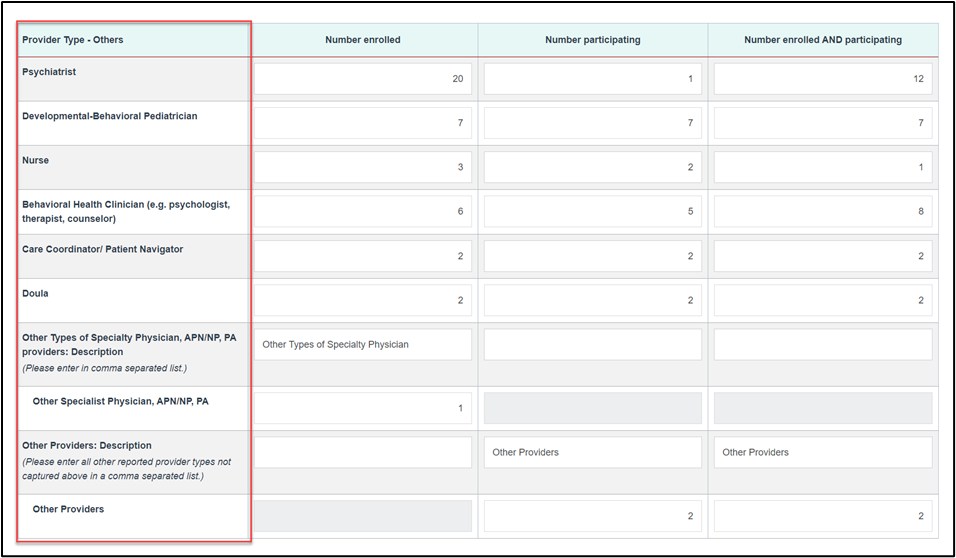
Provider Type – Unknown - The grantee will see a table with the following columns: Provider Type - Unknown, Number enrolled, Number participating and Number enrolled AND participating.
- This is a required question, and the grantee must provide the below information under the Number enrolled, Number participating, Number enrolled AND participating columns:
- Unknown Provider Type: Enter an integer from 0–999,999.
- For Unknown Provider Type, the value entered in Number enrolled AND participating should be equal to or less than the value entered in Number enrolled. And the following validation will display on the Number enrolled AND participating: The value must be less than or equal to Number enrolled.
- For Unknown Provider Type, the value entered in total Number enrolled AND participating should be equal to or less than the value entered in Number participating. And the following validation will display on the Number enrolled AND participating: The value must be less than or equal to Number participating.
 Total Number of Providers - The grantee will see a table with the following columns: Total, Number enrolled, Number participating and Number enrolled AND participating).
- Total (Number enrolled): This will be automatically calculated as a sum of values entered in Number enrolled column in Provider Type - Primary Care Providers (non-specialty), Provider Type – Others and Provider Type – Unknown
- Total (Number participating): This will be automatically calculated as a sum of values entered in Number participating column in Provider Type - Primary Care Providers (non-specialty), Provider Type – Others and Provider Type – Unknown
- Total (Number enrolled AND participating): This will be automatically calculated as a sum of values entered in Number enrolled AND participating column in Provider Type - Primary Care Providers (non-specialty), Provider Type – Others and Provider Type – Unknown

|
| Section ii a. Use of program consultation and care coordination support services.Number of provider contacts with the program for consultation (teleconsultation or in-person), care coordination support, or both. |
- A note will display under this section as follows:
Care Coordination Support: In context of MMHSUD/PMHCA, care coordination support means, at minimum, that the program provides resources and referrals to a provider when they contact the program, or to the patient/family when the program works with patients/families directly. In these programs, "care coordination support" is synonymous with "providing resources and referrals" - The grantee will see a table with the following columns: Type of Contact and Number of provider contacts with the program for services.
- This is a required question, and the grantee must provide the below information under the Number of provider contacts with the program for services column:
- Consultation Only: Enter an integer from 0–999,999.
- Care Coordination Support Only: Enter an integer from 0–999,999.
- Both: The grantee must provide the provider contacts for those seeking both Consultation and Care Coordination and the following validation will display: Enter an integer from 0–999,999.
- Total consultations: This auto-calculated field displays the sum for Consultation Only and Both.
- Total care coordination support: This auto-calculated field displays the sum for Care Coordination Support Only and Both.
- Total (All Provider Contacts): This auto-calculated field displays the sum for Consultation Only, Care Coordination Support Only and Both.

|
| Section ii b. Use of program consultation and care coordination support services. Number of consultations and referrals given to providers. |
- A note will display under this section as follows:
Telehealth is the use of electronic information and telecommunication technologies to support and promote long-distance clinical consultation, patient and professional health-related education, public health and health administration. Permitted telehealth modalities between providers include (but are not limited to): real-time video, telephonic communications, electronic mail (email) with encryption, store-and-forward imaging, and mobile health (mHealth) applications.
Referrals are given to providers (or directly to the patients/families) by the program to introduce specific health providers or services. Recommending "family therapy" without providing a specific provider name or practice would not be considered a referral, but a recommendation for treatment. Referrals are typically provided using resources included in the referral database. Referrals fall under the category of care coordination support in the context of MMHSUD/PMHCA. - The grantee will see a table with the following columns: Consultation or referral and Number of consultations or referrals given.
- This is a required question, and the grantee must provide the below information under the Number of consultations or referrals given column:
- Consultations via telehealth: Enter an integer from 0–999,999.
- Consultations in-person: Enter an integer from 0–999,999.
- Referrals: Enter an integer from 0–999,999.
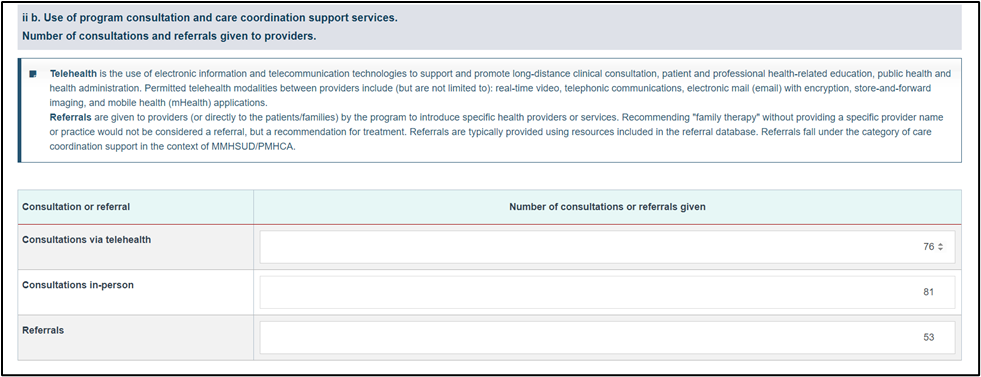
|
|
Please indicate the condition(s) about which providers received consultation (teleconsultation or in-person) or care coordination support services from the program. - A note will display under this section as follows:
If the patient has a diagnosed condition, but the provider is calling about another condition, a different presenting concern, or another reason, please count the reason(s) the provider is calling the program. If the patient does not have a diagnosis, the reason for contact can be a suspected diagnosis, diagnostic impression, presenting concerns/symptoms, suspected problem, or another reason. The condition(s) selected should be the reason(s) the provider is calling for consultation (teleconsultation or in-person) or care coordination support services. Specify the number of contacts for each condition. Each contact can involve more than one condition. - This is a required question and the grantee must provide the number of contacts for each condition applicable.
- Anxiety disorders: Enter an integer from 0–999,999.
- Depressive disorders (excluding postpartum depression): Enter an integer from 0–999,999.
- Postpartum depression: Enter an integer from 0–999,999.
- Bipolar and related disorders: Enter an integer from 0–999,999.
- Attention-Deficit/ Hyperactivity Disorder (ADHD): Enter an integer from 0–999,999.
- Autism Spectrum Disorder: Enter an integer from 0–999,999.
- Disruptive, impulse-control, and conduct disorders: Enter an integer from 0–999,999.
- Neurodevelopmental disorders (including developmental delay and intellectual disabilities): Enter an integer from 0–999,999.
- Feeding and eating disorders: Enter an integer from 0–999,999.
- Obsessive-compulsive and related disorders: Enter an integer from 0–999,999.
- Trauma and stressor-related disorders: Enter an integer from 0–999,999.
- Schizophrenia spectrum and other psychotic disorders: Enter an integer from 0–999,999.
- Substance-related disorders-alcohol: Enter an integer from 0–999,999.
- Substance-related disorders-marijuana: Enter an integer from 0–999,999.
- Substance-related disorders-nicotine: Enter an integer from 0–999,999.
- Substance-related disorders - opioids. Enter an integer from 0–999,999.
- Substance-related disorders - Other - Description: This is an optional question, and the text field accepts text, numbers, and special characters (not to exceed 1000 characters).
- Substance-related disorders – Others. This is a required field if description is entered in Substance-related disorders - Other - Description field and the following validation will display: Enter an integer from 0–999,999.
- Suicidality or self-harm. Enter an integer from 0–999,999.
- Other – Description: This is an optional question, and the text field accepts text, numbers, and special characters (not to exceed 1000 characters).
- Other: This is a required field if description is entered in Other – Description field and the following validation will display: Enter an integer from 0–999,999.


|
|
- This is a required section if the grantee has selected PMHCA in response to the Please select the program you are reporting about question above.
- The grantee will see a table with the following columns: Member of mental health team, Number of consultations provided, and Number of referrals provided.
- This is a required question and the grantee must provide the below information under the Number of consultations provided and Number of referrals provided columns:
- Psychiatrist: Enter an integer from 0–999,999.
- Psychologist: Enter an integer from 0–999,999.
- Social Worker: Enter an integer from 0–999,999.
- Counselor: Enter an integer from 0–999,999.
- Care Coordinator: Enter an integer from 0–999,999.
- Other behavioral clinicians: Enter an integer from 0–999,999.
- Other Description: This is an optional question, and the text field accepts text, numbers, and special characters (not to exceed 1000 characters).
- Other: This is a required field if description is entered in Other – Description field and the following validation will display: Enter an integer from 0–999,999.
- Total: This will be automatically calculated.

|
|
This is a required section within A. Provider Consultation and Training tab and the grantee must enter the data in following sections: - Number and types of providers trained.
- Total number of trainings held.
A note will display under this section as follows: Training refers to education programs or sessions that serve to enhance the knowledge and/or maintain the credentials and licensure of professional providers. Training may also serve to enhance the knowledge base of community outreach workers, families, and other members who directly serve the community. Examples of trainings include mental or behavioral health conditions, medication, screening and assessment, treatment modalities, trauma, etc. Conference presentations would be considered training if training was the intent of the presentation. A conference presentation that describes an intervention or program would not be considered training. |
| Section i. Number and types of providers trained. |
Provider Type - Primary Care Providers (non-specialty) - The grantee will see a table with the following columns: Provider Type - Primary Care and Number Trained.
- This is a required section, and the grantee must provide the below information under the Number Trained column:
- Pediatrician: Enter an integer from 0–999,999.
- Family Medicine: Enter an integer from 0–999,999.
- OB/GYN: Enter an integer from 0–999,999.
- Internal Medicine: Enter an integer from 0–999,999.
- Advanced Practice Nurse/Nurse Practitioner: Enter an integer from 0–999,999.
- Certified Nurse Midwife: Enter an integer from 0–999,999.
- Physician Assistant: Enter an integer from 0–999,999.
- Total Primary Care: This will be automatically calculated.

Provider Type - Others - The grantee will see a table with the following columns: Provider Type – Others and Number Trained.
- This is a required section, and the grantee must provide the below information under the Number Trained column:
- Psychiatrist: Enter an integer from 0–999,999.
- Developmental-Behavioral Pediatrician: Enter an integer from 0–999,999.
- Nurse: Enter an integer from 0–999,999.
- Behavioral Health Clinician (e.g. psychologist, therapist, counselor): Enter an integer from 0–999,999.
- Care Coordinator/ Patient Navigator: Enter an integer from 0–999,999.
- Doula: Enter an integer from 0–999,999.
- Other Types of Specialty Physician, APN/NP, PA providers: Description: This is an optional question, and the text field accepts text, numbers, and special characters (not to exceed 1000 characters).
- Other Specialist Physician, APN/NP, PA: This is a required field if description is entered in Other Types of Specialty Physician, APN/NP, PA providers: Description field and the following validation will display: Enter an integer from 0–999,999.
- Other Providers: Description: The grantee may enter all other reported provider types not captured above in a comma separated list. This is an optional question, and the text field accepts text, numbers, and special characters (not to exceed 1000 characters).
- Other Providers: This is a required field if description is entered in Other Providers: Description field and the following validation will display: Enter an integer from 0–999,999.

Provider Type - Unknown - The grantee will see a table with the following columns: Provider Type – Unknown and Number Trained.
- This is a required section, and the grantee must provide the below information under the Number Trained column:
- Unknown Provider Type: Enter an integer from 0–999,999.

Total Number of Providers Trained - The grantee will see a table with the following columns: Total and Number Trained.
- Total: This section will be automatically calculated as a sum of Total Primary care providers, Total Others and Unknown Providers.
 |
|
Total number of trainings held - This will be automatically calculated as the sum of the number of trainings reported in all the integer fields in Topics covered by trainings and number of trainings per topic section below.
- The sum of values entered by the grantee in Training mechanisms used section should be equal to the value in Total number of trainings held question above. And the following validation will display on Total number of trainings held question if the values doesn’t match: The total for A.2.ii.b (total trainings held by mechanism) must match A.2.ii.a. (total trainings held by topic).

Topic focus of trainings and number of trainings per topic focus - A note will display under this section as follows:
Each individual training should be associated with only one topic focus; the sum of trainings for each individual training topic focus should equal the total number of trainings held. - This is a required section, and the grantee must provide the number of trainings covering below topics that are applicable.
- Mental or behavioral health conditions-related trainings (e.g., anxiety, depression, substance use disorder, ADHD, OCD, eating disorders, tics, Autism, developmental delay, behavioral dysregulation, etc.) Please include comprehensive trainings that cover medications, screenings, treatments, etc. for specific conditions in this category: Enter an integer from 0–999,999.
- Medication-focused trainings: Enter an integer from 0–999,999.
- Screening and assessment/testing-focused trainings: Enter an integer from 0–999,999.
- Treatment modality-focused trainings: Enter an integer from 0–999,999.
- Trauma focused trainings: Enter an integer from 0–999,999.
- Parent and family-focused trainings: Enter an integer from 0–999,999.
- Practice Improvement/Systems Change/Quality Improvement (e.g., practice workflows, integrating protocols into the EHR, integrating behavioral health into primary care, expanding community referrals, ensuring culturally and linguistically appropriate services): Enter an integer from 0–999,999.
- COVID-19-focused trainings: Enter an integer from 0–999,999.
- Other – Description: This is an optional question, and the text field accepts text, numbers, and special characters (not to exceed 1000 characters).
- Other: This is a required field if description is entered in Other - Description field and the following validation will display: Enter an integer from 0–999,999.

Training mechanisms used - A note will display under this section as follows:
Each individual training should be associated with only one mechanism; the sum of trainings for each individual training mechanisms should equal the total number of trainings held. - This is a required section, and the grantee must provide the number of trainings using below Training Mechanisms.
- In-person: Enter an integer from 0–999,999.
- Project ECHO® (distance learning cohort): Enter an integer from 0–999,999.
- ECHO-like (distance learning cohort): Enter an integer from 0–999,999.
- Web-based: Enter an integer from 0–999,999.
- Hybrid (combination of in-person and virtual): Enter an integer from 0–999,999.
- Other – Description: This is an optional question, and the text field accepts text, numbers, and special characters (not to exceed 1000 characters).
- Other: This is a required field if description is entered in Other - Description field and the following validation will display: Enter an integer from 0–999,999.
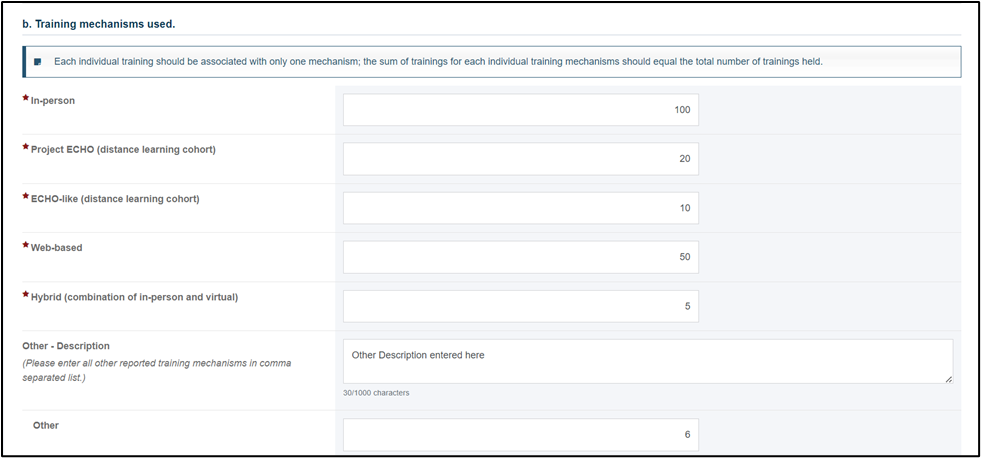
|
|
In this section, the grantee can enter additional information (not to exceed 5,000 characters). The Comments field accepts text, numbers, and special characters. 
- The Next Tab button will save the validated information and the grantee will navigate to the next tab.
- The Save button will save the validated information captured in the form and the grantee will remain on the same form.
- The Save and Continue button will save the validated information and the grantee will navigate to the next form.
- The Go to Previous Form button will navigate to the previous form without saving any previously unsaved information.
|
|
The grantee may click on this tab and see the following sections: - 1. Number of individuals for whom a provider contacted the program for consultation (teleconsultation or in-person) or care coordination support services
- 2. Number of individuals recommended for referral and/or treatment, among those for whom a provider contacted the program for consultation (teleconsultation or in-person) or care coordination support services.
- 3. Percent of individuals screened for behavioral or mental health condition [Optional]
|
|
NOTE: If the grantee user selected PMHCA on Tab A: - Children and Adolescent rows will be enabled for the grantee to enter data in all three tables of Tab B.
- Pregnant and postpartum women rows will remain disabled for all three tables of Tab B.
If the grantee user selected MMHSUD on Tab A: - Pregnant and postpartum women rows will be enabled for the grantee to enter data in all three tables of Tab B.
- Children and Adolescent rows will remain disabled in all three tables of Tab B.
This is a required section within B. Individuals Served tab and grantee must answer the following questions: - A note will display under this section as follows:
For this measure, you may use provider zip codes to identify rural or underserved counties if the patient zip code is unavailable. The use of patient zip codes is not required. HRSA defines rural areas as all counties that are not designated as parts of metropolitan areas (Mas) by the Office of Management and Budget. In addition, HRSA uses Rural Urban Commuting Area Codes to designate rural areas within Mas. This rural definition can be accessed at https://www.hrsa.gov/rural-health/about-us/what-is-rural. If the county is not entirely rural or urban, follow the link for "Rural Health Grants Eligibility Analyzer" to determine if a specific site qualifies as rural based on its specific census tract within an otherwise urban county. Underserved areas are defined by the following terms: Any Medically Underserved Area/Population (MUA/P); or a Partially MUA/P. MUA/Ps are accessible through https://data.hrsa.gov/tools/shortage-area/mua-find - The grantee will see a table with the following columns: Individuals, Total, and Rural/Undeserved.
- This is a required section, and the grantee must provide the below information under the Total and Rural/Undeserved column:
- Children 0-11: Enter an integer from 0–999,999.
- Adolescents 12-21: Enter an integer from 0–999,999.
- Children and Adolescents – Age Unknown: Enter an integer from 0–999,999.
- Pregnant or postpartum women : Enter an integer from 0–999,999.
- Total: This row will only display if the grantee selects PMHCA in response to the Please select the program you are reporting about question on Tab A. This will be automatically calculated as sum of values entered in Total and Rural/underserved columns for the Children 0-11, Adolescents 12-21 and Children and Adolescents – Age Unknown
- The value entered in Rural/Underserved must be less than or equal to the value entered in Total column for each row. And the following validation will display on Rural/Underserved field: Rural/Underserved should be less than or equal to Total
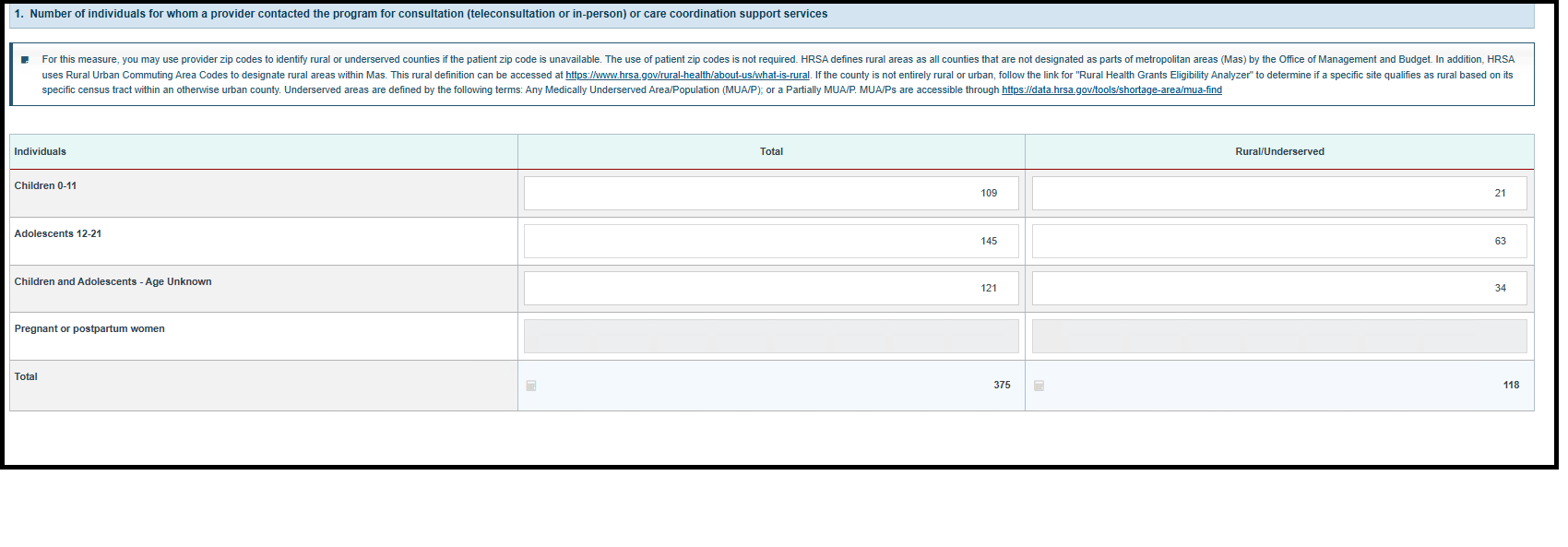
|
|
This is a required section within B. Individuals Served tab and grantee must answer the following questions: - A note will display under this section as follows:
Treatment is the provision, coordination, or management of health care and related services among health care providers. Providers contacting the programs for consultation may or may not be the ones providing the treatment that is recommended by the consulting provider. - The grantee will see a table with the following columns: Individuals, Referral only, Treatment only, Both referral and treatment, and
- This is a required section, and the grantee must provide the below information under the Referral only, Treatment only, and Both referral and treatment columns:
- Children 0-11: Enter an integer from 0–999,999.
- Adolescents 12-21: Enter an integer from 0–999,999.
- Children and Adolescents – Age Unknown: Enter an integer from 0–999,999.
- Pregnant or postpartum women : Enter an integer from 0–999,999.
- Total: This row will only display if the grantee selects PMHCA in response to the Please select the program you are reporting about question on Tab A. This will be automatically calculated as sum of values entered in Referral only, Treatment only and Both referral and treatment only columns for the Children 0-11, Adolescents 12-21 and Children and Adolescents – Age Unknown rows

|
|
This is an optional section within B. Individuals Served tab and grantee may answer the following questions: - A note will display under this section as follows:
Fields not required: Leave fields blank if you have no data to provide.
Numerator:
For PMHCA: Number of children and adolescents, 0-21 years of age, for whom a provider contacted the mental health team for consultation or referral, who received at least one screening for a behavioral health condition using a standardized validated tool.
For MMHSUD: Number of pregnant or postpartum women, for whom a provider contacted the program for consultation or care coordination support, who received at least one screening for a behavioral health condition (depressions, anxiety, or substance use, separately) using a standardized validated tool.
Denominator:
For PMHCA: Number of children and adolescents, 0-21 years of age, for whom a provider contacted the mental health team for consultation or referral.
For MMHSUD: Number of pregnant or postpartum women, for whom a provider contacted the program for consultation or care coordination support. - The grantee will see a table with the following columns: Individuals, Numerator, Denominator and %.
- This is an optional section, and the grantee may provide the below information under the Numerator and Denominator columns or may leave the fields blank if no data to provide:
- Children 0-11 screened for behavioral or mental health condition: This field accepts integer values from 0–999,999.
- Adolescents 12-21 screened for behavioral or mental health condition: This field accepts integer values from 0–999,999.
- Children and Adolescents – Age Unknown screened for behavioral or mental health condition: This field accepts integer values from 0–999,999.
- Pregnant or postpartum women screened for behavioral or mental health condition: This field accepts integer values from 0–999,999.
- Pregnant or postpartum women screened for depression: This field accepts integer values from 0–999,999.
- Pregnant or postpartum women screened for anxiety: This field accepts integer values from 0–999,999.
- Pregnant or postpartum women screened for substance use: This field accepts integer values from 0–999,999.
- Total: This row will only display if the grantee selects PMHCA in response to the Please select the program you are reporting about question on Tab A. This will be automatically calculated as the sum of the numerators for the three categories, sum of the denominators for the three categories, and a percentage calculated from that sum of the numerators and denominators for the Children 0-11, Adolescents 12-21 and Children and Adolescents – Age Unknown
- Numerator value should be greater than or equal to Denominator and “%” value should never be greater than 100. And the following validation will display on Denominator field: Denominator must be greater than or equal to Numerator.
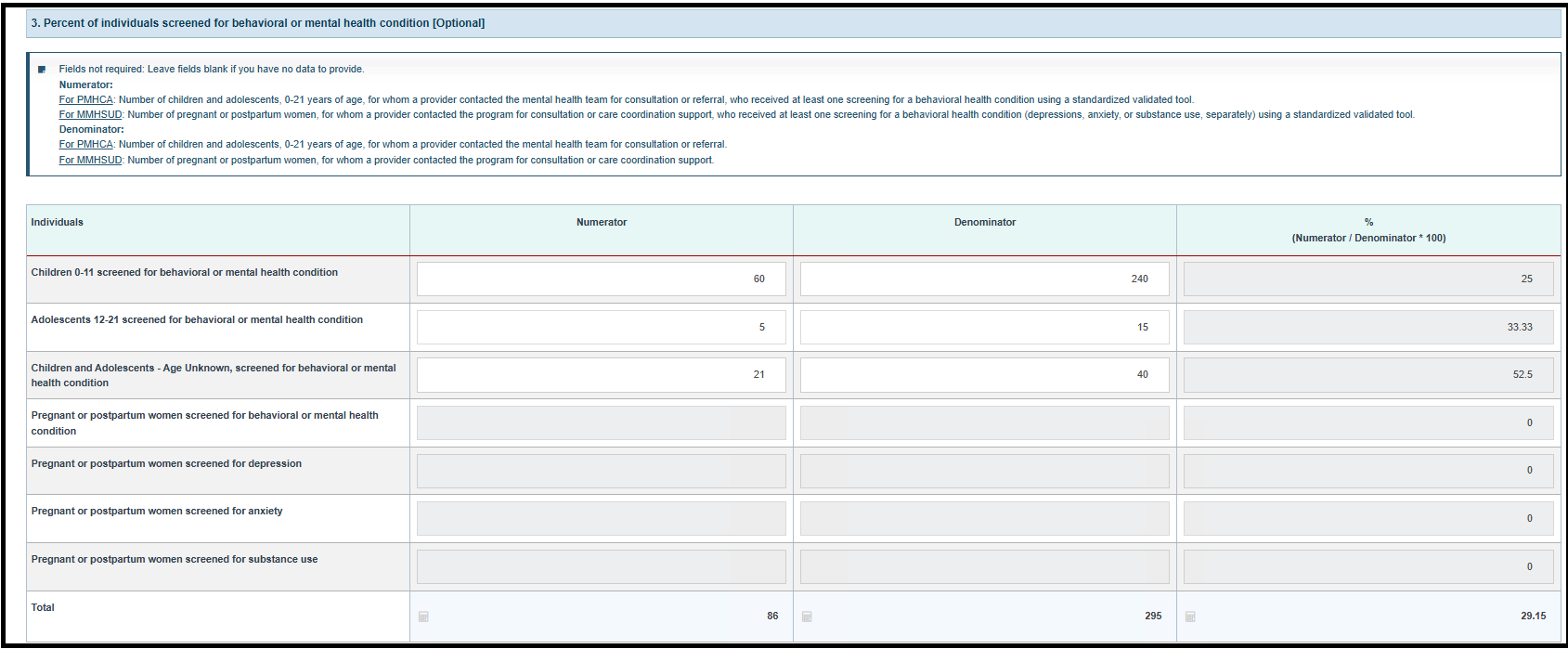
|
|
In this section, the grantee can enter additional information (not to exceed 5,000 characters). The Comments field accepts text, numbers, and special characters. 
- The Previous Tab button will save the validated information and the grantee will navigate to the previous tab.
- The Save button will save the validated information captured in the form and the grantee will remain on the same form.
- The Save and Continue button will save the validated information and the grantee will navigate to the next form.
- The Go to Previous Form button will navigate to the previous form without saving any previously unsaved information.
|
|
- For New Competing Performance Reports (NCPRs), Non-Competing Continuation Performance Reports (NCCPRs) and Project Period End Reports (PPERs), the grantee must provide data under the two tabs.
- Data checks and validations for all the description fields:
- Fields accept text, numbers, and special characters.
- Fields accept a maximum of 1,000 characters.
- The Comments text box will accept text, numbers, and special characters (not to exceed 5,000 characters).
|



























